India’s Potential for Food Security and Climate Stabilization
Satellite image of the Deccan Trap volcanics (mostly basalts) in Maharashtra. Note the richness of vegetation in terraced areas where soils have formed (Image from Planet Labs, Inc).
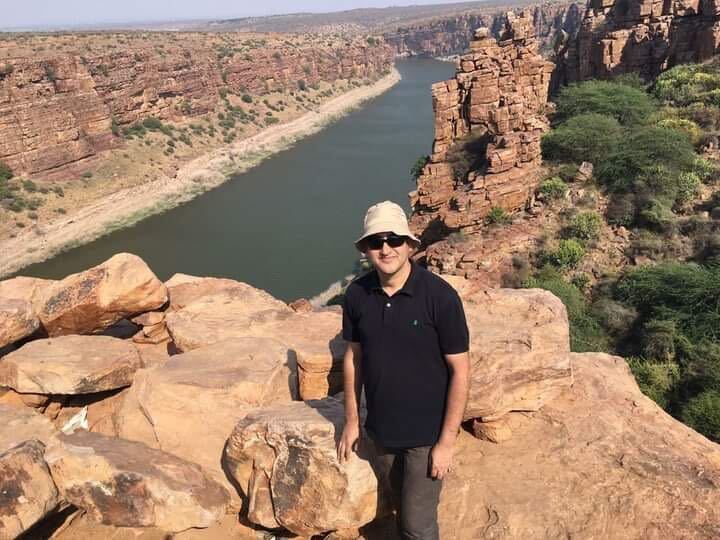
The World Health Organization Director General Dr. Tedros Ghebreyefus has warned: “There is no vaccine for climate change.” While this stark warning is currently true, recent advances in nature-based carbon dioxide removal (CDR) strategies may offer an effective treatment of the problem. One such strategy was proposed at the June 12, 2024, Monthly Scientific Meeting of the Geological Society of India.
In this presentation, Dr. Ishfaq Ahmad Mir, a Senior Geologist with the Geological Survey of India, showed how natural silicate rock dust applied to agricultural fields can effectively remove carbon dioxide from the atmosphere while simultaneously enriching and restoring depleted soils (a process called soil remineralization). The biogeochemical processes discussed by Dr. Mir thus have major implications for addressing both climate change and food insecurity. Of particular importance, Dr. Mir showed that India’s unique geology, soils, and climate make it particularly well-suited for silicate rock-based soil remineralization and CDR. Dr. Mir suggests that a rigorous pan-India geochemical mapping program is required for India to reach its full potential as a global leader in nature-based carbon removal. This geospatial database would be an invaluable tool for decision-makers tasked with developing policies for sustainable development, agricultural improvements, climate change mitigation and adaptation, and public health.
Unprecedented warming: the Anthropocene
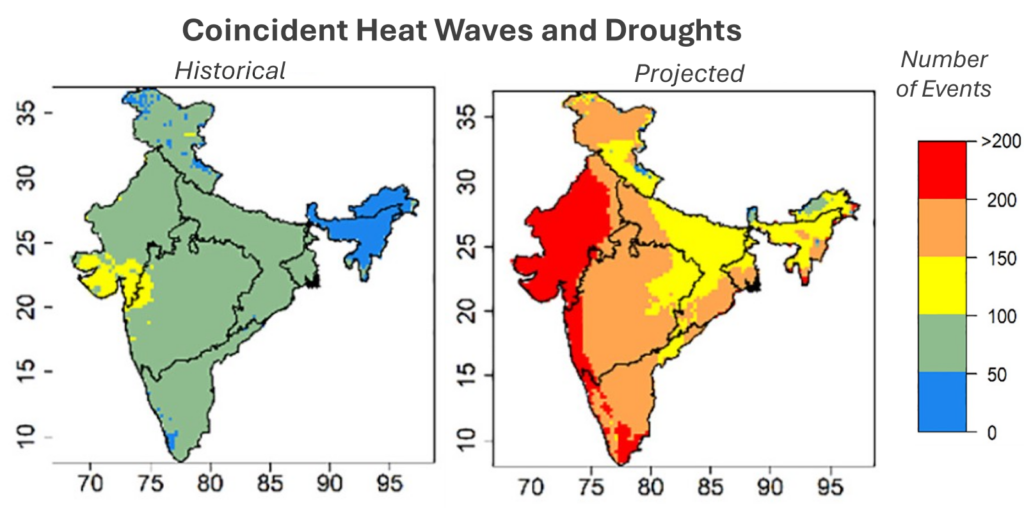
In his talk, Dr. Mir explained that he was inspired to investigate methods for addressing climate change by his own observations of increased heat and climate disasters as he traveled throughout India for his geological fieldwork. His observations are backed by recent studies. For example, a 2022 study by the National Institute of Technology Warangal, India, published in Science of the Total Environment (Das et al., 2022) shows that the number of coincident heat waves and droughts are projected to more than double over the next forty years (Figure 1).
As Dr. Mir explained, these increasingly frequent events represent regional manifestations of global warming associated with the relatively recent spike in atmospheric carbon dioxide levels. As a geologist, Dr. Mir offered a unique perspective on the nature of climate change. He referred to the Anthropocene; a proposed geologic epoch marked by the global influence of human activity on Earth’s climate and environment. While not accepted as an official part of the geologic time scale, the concept of the Anthropocene highlights the planet-scale changes humanity has made over just a tiny fraction of Earth’s history. For example, Dr Mir presented graphs demonstrating the geologically unprecedented rise in global carbon dioxide (CO2) levels in the atmosphere (Figure 2).
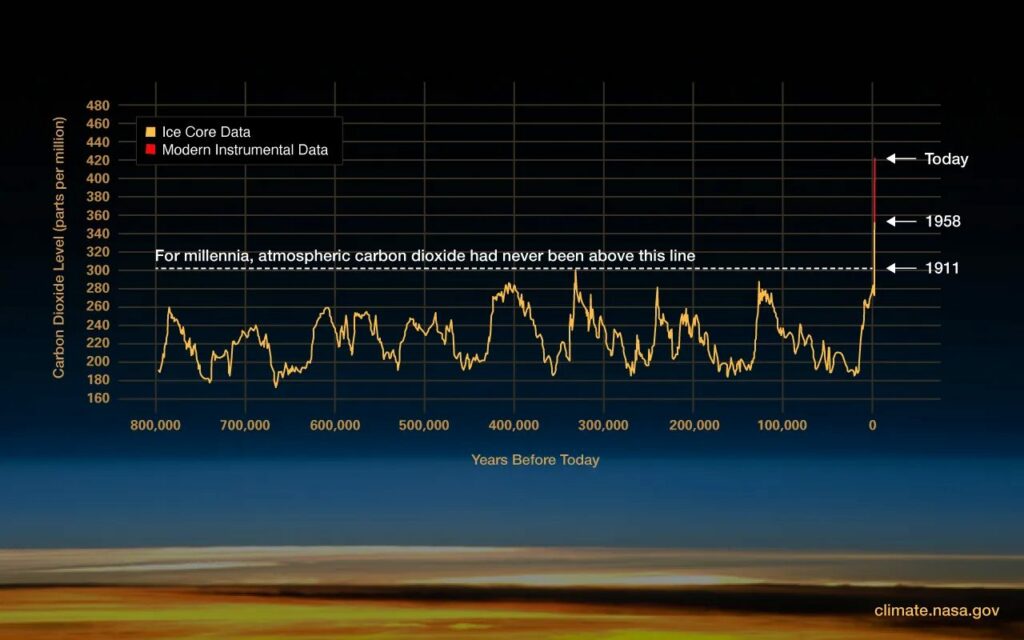
This CO2 spike corresponds to a spike in global average temperature and a rise in extreme weather events. Dr. Mir points out that the dramatic jump in Earth’s population from around 1 billion in 1850 to around 8 billion in 2024 directly correlates with the surge in CO2 emissions from fossil fuel use. He also points out that there is now scientific evidence that the resulting Anthropocene climate change is likely contributing to a new mass extinction event on our planet (e.g., see Barnosky et al., 2011).
As a geologist, Dr. Mir is looking to Earth systems processes for clues on how to effectively mitigate and adapt to the global environmental changes humanity is causing. Of particular interest is how Earth’s carbon cycle intersects with the geologic rock cycle. As Dr. Mir and other current and past researchers have pointed out, it is through this intersection that humanity may be able to nudge the Earth system back toward climate stability.
A nature-based solution: Earth’s thermostat and rock weathering
Over Earth’s geologic history (i.e., over multimillion-year time scales), the atmospheric concentration of carbon dioxide has been largely controlled by the balance between silicate rock weathering and natural emissions from volcanoes (Brantly et al., 2023). The weathering of silicate rocks (e.g., basalt) naturally removes carbon dioxide from the atmosphere by converting it to stable forms of carbon called carbonates. This process involves dissolving CO2 gas in rainwater or soil pore waters, where it forms a weakly acidic substance called carbonic acid. This weak acid chemically attacks and weathers silicate minerals to form soils. In this process, the dissolved CO2 is converted into stable carbonate molecules, which rivers may transport to the ocean, where they precipitate as carbonate minerals like calcite. Over millennia, these carbonate minerals are converted to limestone and other carbonate rocks, which naturally locks up the carbon for millions of years.
A key aspect of this process is that the rate of chemical weathering increases with increasing temperature. Therefore, when global temperatures increase (in response to rising CO2 levels), so does the rate of CO2 removal by natural chemical weathering. This is Earth’s thermostat, a negative feedback loop within Earth’s carbon/rock cycle that buffers Earth’s climate and keeps global temperatures within a habitable range. The CO2 buffering process is evident in Figure 2 from 800,000 years ago to near the present day. However, in the last two hundred years or so, the rate of increase in CO2 from anthropogenic sources has tipped the system out of balance. That is, the thermostat can’t keep up.
As Dr. Mir warns, humanity must actively remove CO2 from the atmosphere to avoid runaway global temperatures and the catastrophic consequences for human well-being and life in general. In his talk, Dr. Mir highlighted the scale of carbon dioxide removal required, saying, “In addition to reduction of emissions, CO2 removal (CDR) is required at multi-gigatonne (Gt) annual scale by mid-century to meet the goals of the Paris Agreement and limit warming to 1.5 or even 2°C.”
This raises the question: what global-scale process could be used to remove these levels of carbon dioxide from the atmosphere? This is where Dr. Mir and other researchers familiar with Earth systems processes come in. “Why not look to nature’s own solution?” they ask. Why not look to the natural process of rock weathering?
This is the solution that Dr. Mir focused on in his presentation. As stated above, the challenge is that the rate of anthropogenic CO2 emissions has overloaded the system. Earth’s rock weathering thermostat cannot keep up. Therefore, the central question that Dr. Mir first addressed in his presentation was: “Is it possible to accelerate weathering to remove CO2 from air?” The answer is yes, it involves a process that has recently become known as enhanced rock weathering (ERW). This process involves crushing and grinding silicate rock material into a granular material or fine powder. Due to the smaller grain size, the crushed material weathers many times faster than intact rock formations. This rock dust material can then be spread onto agricultural lands where its weathering rates are further accelerated by the biological processes in the soil.
The concept of using rock weathering specifically for carbon dioxide removal is a relatively new idea. It is now receiving extensive R&D attention from several international startups, non-profit organizations, and university researchers from all over the world. However, the concept of using natural rock dust to treat agricultural soils is not new at all. For centuries, it has been used as a traditional farming practice. For example, the Aztec people (ca 1200-1500 AD) applied silts dredged from canals to fertilize crops, the Hunza people of Northern Pakistan (renowned for their longevity and overall health) used rock dust from glacial deposits to enrich their soils, and for the past 200 years farmers in the Canary Islands have used friable volcanic material to retain moisture and deliver nutrients to soils in their arid climate (Chesworth et al., 1983). In the scientific community, research into soil remineralization, the use of natural rock dust to enrich and restore depleted and degraded soils, goes back to the late 19th century (Aitken, 1887 and Hensel, 1894). For reviews of more recent developments in soil remineralization, see Campe et al., 2022 and Swoboda et al., 2022. As Dr Mir points out, the beauty of using rock dust for agricultural purposes is that it is a scalable practice that can be used to simultaneously fight climate change and food insecurity.
Using rock weathering to fight climate change and food insecurity: India as a global leader
As mentioned above, enhanced rock weathering is a process that converts atmospheric CO2 to stable carbonates, which can be stored naturally over geologic time scales as carbonate rocks. The amount of carbon that can be removed from the atmosphere by this process is strongly dependent on the type of rock used and the amount of farmland available for rock dust application. India excels in both of these areas. For example, India hosts one of the largest basalt provinces in the world in the Deccan Traps. The chemical composition of the Deccan Trap basalts makes them ideal for both CDR and agricultural use.
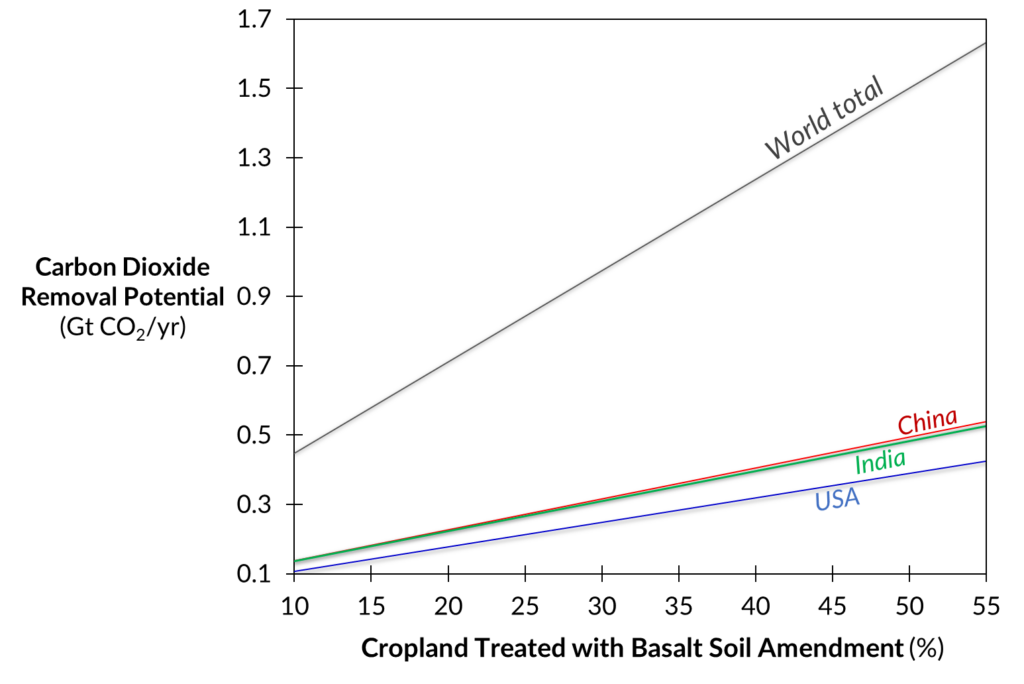
India also hosts the world’s largest coverage of cropland (around 168 million hectares, according to FAOSTAT database). In a landmark study, researchers from the Leverhulme Centre for Climate Change Mitigation at the University of Sheffield showed that India and China are the world’s top two countries in terms of ERW potential, as shown in Figure 3. India, China, and the US have the potential to remove hundreds of millions of tonnes of CO2 from the atmosphere per year (Beerling et al., 2020).
Some of India’s vast potential for CDR is beginning to be tapped. For example, the non-profit organization Mati Carbon (a project of the Swaniti Initiative) has deployed thousands of tonnes of basalt rock in the states of Madhya Pradesh and Chhattisgarh and is responsible for the first-ever delivery of engineered carbon dioxide removal credits in the Global South (see our previous article for more information on Mati Carbon’s early work).
Both Mati Carbon and Dr Mir emphasize that the CDR potential of applying rock dust to croplands is only one of the many benefits of the practice. In his presentation, Dr. Mir discussed the many agricultural benefits of rock dust, especially when combined with organic amendments such as compost and biochar (Figure 4).
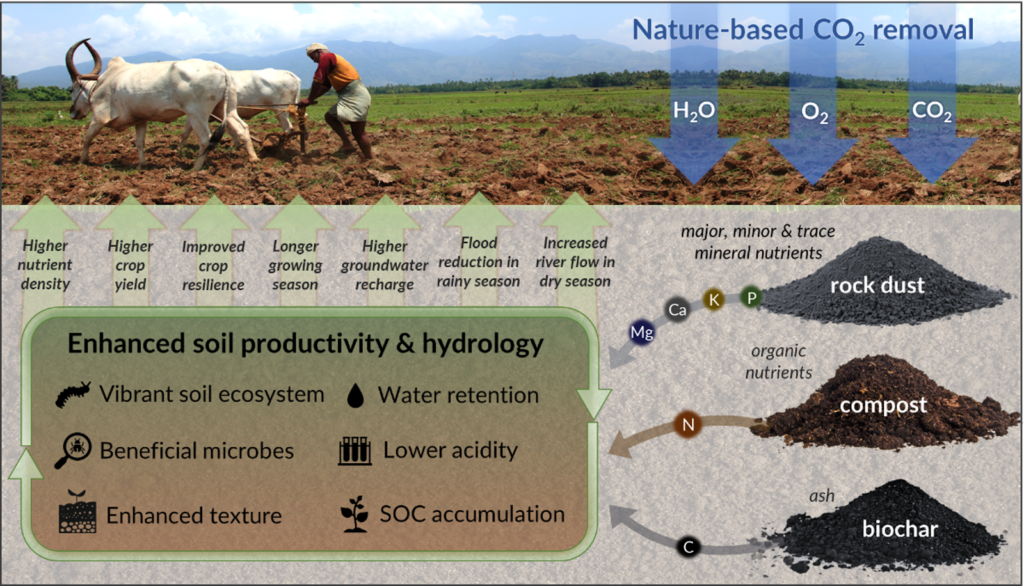
Dr. Mir specifically called out the following benefits of soil remineralization with rock dust:
- Slow release of nutrients reduces synthetic fertilizers use, thus counteracting eutrophication associated with phosphorus and nitrogen runoff from fields
- Improves nutrient intake by plants and has been demonstrated to significantly increase yields in field trials
- Rebalances soil pH
- Builds humus, which increases soil organic carbon accumulation and helps prevent soil erosion
- Increases resistance to disease and reduces pesticide use.
- Can be scaled at relatively low cost
- Provide a new source of income to farmers and miners
- Provides nutrition-dense foods, thus improving well-being and reducing medical expenses
Dr Mir also pointed out that the rock types commonly used for ERW (such as basalt) contain the full spectrum of essential plant nutrients (except for nitrogen). This includes the major nutrients phosphorus and potassium, minor essential nutrients such as calcium and magnesium, and trace element nutrients such as copper, molybdenum, zinc, and nickel. Thus, in addition to high yields, food crops grown in rock dust-treated soils are nutrient-dense, thus fighting nutrient deficiency issues as well as food insecurity.
As Dr. Mir highlights: “Healthy soils aid in the growth of healthy plants, reduce atmospheric CO2 levels, and stabilize climate change. Food’s nutritional value improves health and lowers the need for and cost of medical treatment.”
Scale-up of enhanced rock weathering in India: the importance of geochemical mapping
Ultimately, Dr. Mir’s research into soil remineralization and ERW is geared towards expanding the practice to all of India’s agricultural regions, which can benefit from it. This ambitious goal will require a significant country-wide mapping program to provide the spatial geochemical, geologic, and soil characteristics data needed to plan and optimize rock dust sourcing and applications. In his presentation, Dr. Mir explained that the mapping program will build on existing efforts, such as the Geological Survey of India’s National Geochemical Mapping (NGCM) project. The aim of this effort is to produce pan-India maps that include all the major, minor, and trace elements that impact environmental/ecosystem health, agricultural productivity, and public safety. This geospatial database will provide valuable information for mineral exploration, agriculture, environmental studies, public health, and sustainable development. The maps will also empower policymakers to make informed decisions that support sustainable development, environmental stewardship, and public health. Furthermore, sharing pan-India geochemical maps will benefit research institutions, universities, and NGOs working to improve environmental improvements, sanitation, water quality, and public well-being at the local level.
The pan India maps produced by NGCM, along with regional soil and geologic maps, will allow enhanced weathering practitioners to tailor rock dust treatments to particular soil types. The geochemical maps will also provide key information on trace element levels, which can be toxic if too high or growth-limiting if too low. For example, nickel is considered a soil contaminant when present in concentrations greater than 150 parts per million but is also a nutritionally essential trace metal for microorganisms, animal species, and plants (Kumar et al., 2021). Knowing the geochemical baseline for both rocks and soils will allow ERW practitioners to avoid overloading soils in some regions with trace metals, while filling nutritional deficiencies for others. For example, Figure 5 shows the deficiency and toxicity ranges for copper in most plants, and demonstrates the measurement precision required to accurately assess whether a growing media (e.g., soil pore waters) has deficient or toxic levels of trace element nutrients. Dr. Mir is an expert at accurately determining these low element concentrations.
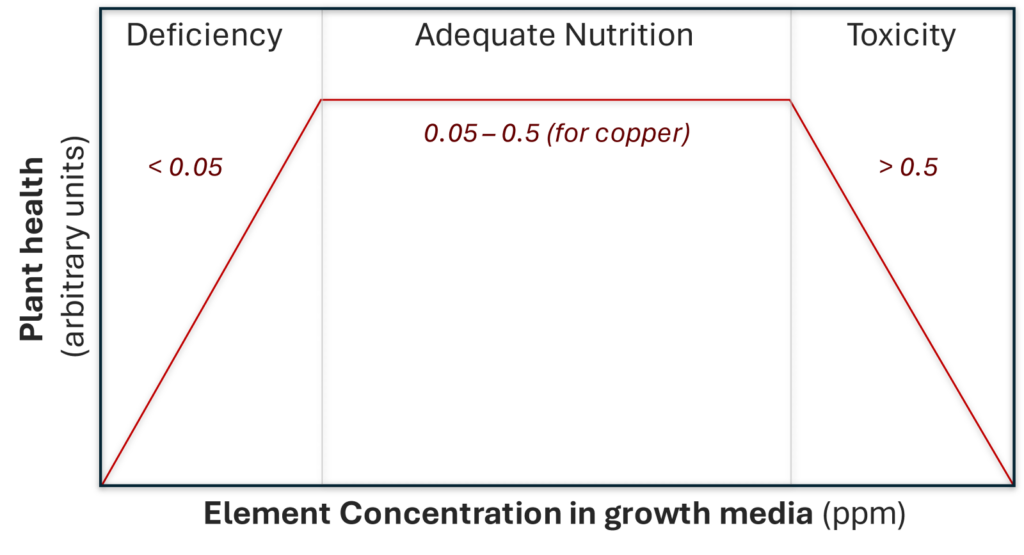
Dr. Mir summed up the need for an expanded geochemical mapping program: “The mapping of nutrient-rich and nutrient-deficient soils, soil pH, and other soil parameters, as well as the identification of agro-mineral provinces that can be mined for enhancing the health of poor soils, particularly in tropical India.”
In association with the pan-India geochemical mapping program Dr. Mir emphasized the need for a national research and development program to address all aspects of the enhanced rock weathering life cycle. These aspects include rock production, distribution, scientific development (e.g., analytical laboratories) and public awareness, education and outreach. As Dr. Mir explained:
For each significant rock/soil/crop/climate system, an optimized application of National rock powder resources must be determined through a national R&D program. The nation’s capacity to adapt to the mounting challenges of population expansion and climate change would be significantly improved by the R&D program.
Based on the success of the Geological Survey of India’s NGCM program, India stands to be a leader in global efforts to apply large-scale geochemical mapping to soil remineralization and ERW efforts in the global south and beyond.
Conclusion
Dr. Mir’s June 12, 2024, presentation to the Geological Society of India marks an important call to action for policymakers and researchers. His thorough review and recommendations offer a clear path forward toward the wider adoption and scale-up of soil remineralization and enhanced rock weathering in India. As Dr. Mir emphasizes, India is perfectly positioned to become a world leader in this field due to its unique geology and vast agricultural lands. When scaled to its full potential in India, this nature-based process has the capacity to remove gigatonne levels of carbon dioxide from the atmosphere while simultaneously increasing crop yield and the nutrient density of foods. When applied in concert with aggressive emission reductions and other environmentally sound CDR strategies such as the sustainable production of biochar from agricultural waste, ERW represents the closest thing to a vaccine for climate change that humanity has at its disposal. The scale-up of this process will invigorate both the mining and agricultural sectors and boost local economies, thus enhancing climate adaptability at local levels. The ideas and programmatic plans Dr. Mir eloquently laid out in his talk represent a true win-win for India and the world.
For a more thorough discussion, see Dr. Mir’s presentation at the Geological Society of India, and his 2024 paper “India’s biogeochemical capacity to attain food security and remediate climate” published in the Journal Environmental Geochemistry and Health, Volume 46, 2024. Dr. Mir will also present his work on August 20, 2024, at the 2024 Goldschmidt Conference in Chicago.
James Jerden is an environmental scientist and science writer focused on researching and promoting sustainable solutions to urgent environmental problems. He holds a Ph.D. in geochemistry from Virginia Tech and a Master’s degree in geology from Boston College. Over the past 20 years, James has worked as a research geochemist and science educator. He joined Remineralize the Earth because of their effective advocacy, research, and partnership projects that support sustainable solutions to urgent environmental issues such as soil degradation (food security), water pollution from chemical fertilizers (water security), deforestation, and climate change. As a science writer for RTE, his goal is to bring the science and promise of soil remineralization to a broad, non-technical audience. When not writing, he can be found at his drum set.
Works Cited
- Aitken, A.P., n.d. Ground feldspar as a potash manure. Transactions Highland Society, Scotland 19, 253–261.
- Barnosky, A.D., Matzke, N., Tomiya, S., Wogan, G.O.U., Swartz, B., Quental, T.B., Marshall, C., McGuire, J.L., Lindsey, E.L., Maguire, K.C., Mersey, B., Ferrer, E.A., 2011. Has the Earth’s sixth mass extinction already arrived? Nature 471, 51–57. https://doi.org/10.1038/nature09678
- Bloodnick, E., 2014. Role of Copper in Plant Culture | PT Growers and Consumers [website]. Premier Tech Growers and Consumers. URL https://www.pthorticulture.com/en-us/training-center/role-of-copper-in-plant-culture (accessed 6.28.24).
- Brantley, S.L., Shaughnessy, A., Lebedeva, M.I., Balashov, V.N., 2023. How temperature-dependent silicate weathering acts as Earth’s geological thermostat. Science 379, 382–389. https://doi.org/10.1126/science.add2922
- Campe, J., Mejbel, M., Patskowski, D., 2022. Remineralization for a Healthy Planet (White Paper). Remineralize the Earth.
- Chesworth, W., Macias-Vazquenz, F., Acquaye, D., Thompson, E., 1983. Agricultural Alchemy: Stones into Bread. Episodes Journal of International Geoscience 6, 3–7. https://doi.org/10.18814/epiiugs/1983/v6i1/002
- Das, J., Manikanta, V., Umamahesh, N.V., 2022. Population exposure to compound extreme events in India under different emission and population scenarios. Science of The Total Environment 806, 1–15. https://doi.org/10.1016/j.scitotenv.2021.150424
- Kumar, A., Jigyasu, D.K., Kumar, A., Subrahmanyam, G., Mondal, R., Shabnam, A.A., Cabral-Pinto, M.M.S., Malyan, S.K., Chaturvedi, A.K., Gupta, D.K., Fagodiya, R.K., Khan, S.A., Bhatia, A., 2021. Nickel in terrestrial biota: Comprehensive review on contamination, toxicity, tolerance and its remediation approaches. Chemosphere 275, 129996. https://doi.org/10.1016/j.chemosphere.2021.129996
- Hensel, J., 1894. Bread from Stones: A New and Rational System of Land Fertilization and Physical Regeneration (Translated from the German, 1894). A.J. Tafel, T.B. and H.B. Cochran, Printers, Lancaster, PA. https://rockdustlocal.com/uploads/3/4/3/4/34349856/bread_from_stones.pdf
- Mir, I.A., Goreau, T.J.F., Campe, J., Jerden, J., 2024. India’s biogeochemical capacity to attain food security and remediate climate. Environmental Geochemistry and Health 46, 1–23. https://doi.org/10.1007/s10653-023-01827-x
- Swoboda, P., Döring, T.F., Hamer, M., 2022. Remineralizing soils? The agricultural usage of silicate rock powders: A review. Science of The Total Environment 807, 150976. https://doi.org/10.1016/j.scitotenv.2021.150976
Support us on Patreon
Thank you for joining us today! Please become a member of RTE and support us on Patreon. Unlike many larger organizations, we work with a team of determined and passionate volunteers to get our message out. We aim to continue to increase the awareness of remineralization to initiate projects across the globe that remineralize soils, grow nutrient dense food, regenerate our forests’ and stabilize the climate – with your help! If you can, please support us on a monthly basis from just $2, rest assured that you are making a big impact every single month in support of our mission. Thank you!

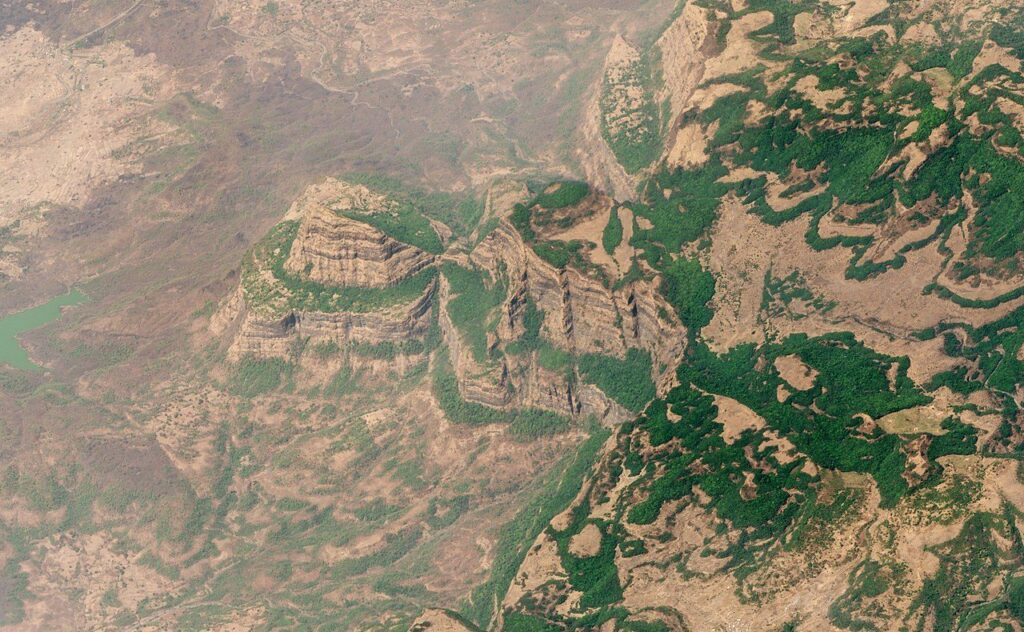






Got something to say?